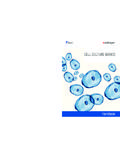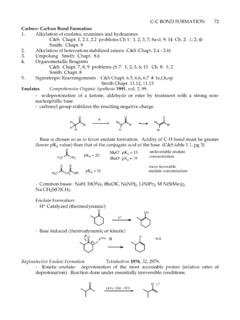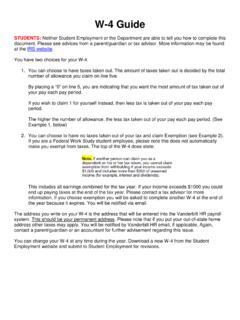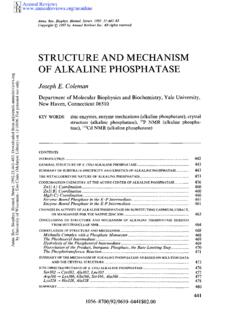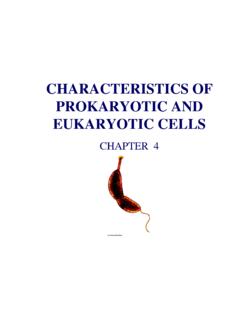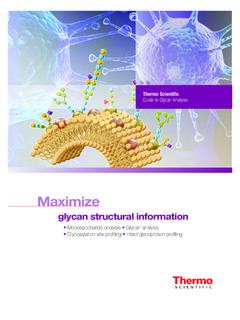Transcription of 27.1: Classification of Amino Acids.
1 157307 Chapter 27: Amino Acids, peptides , and unit: - Amino acidsBiopolymer: the monomeric Amino acids are linked through an amide bond (the carboxylic acids of one AA with the - Amino group of a second) peptide (< 50 Amino acids)protein (> 50 Amino acids)RCO2 HNH2H!- Amino AcidR = sidechainR1H3 NCO2R2H3 NCO2+- H2OR1H3 NHNOCO2R2C-terminusN-terminusPeptide or protein (polypeptide) : Classification of Amino Acids. AA s are classified according to the location of the Amino are 20 genetically encoded - Amino acids found in peptides and proteins19 are primary amines, 1 (proline) is a secondary amine19 are chiral , 1 (glycine) is achiral; the natural configuration of the -carbon is L.
2 !- Amino acid (2- Amino carboxylic acid )CCO2HH2 NHHCCO2 HCHHH2 NHHCCCHHH2 NHHCO2 HHH"- Amino acid (3- Amino carboxylic acid )#- Amino acid (4- Amino carboxylic acid )CO2 HCH3H2 NHCO2 HRH2 NHL-alanineCHOHOHHOHCH2 OHCHOHOHHOHCH2 OHL-erythroseD-erythroseCO2HH2 NHHOHCH3CO2HH2 NHH3 CHCH2CH3L-theronine(2S,3R)L-isoleucine(2 S,3S)CHOCH2 OHHOHD-glyceraldehydeCHOCH2 OHHOHL-glyceraldehyde158309 - Amino acids are classified by the properties of their sidechains. Nonpolar: (S)-(+)-Valine (Val, V)(S)-( )-Tryptophan (Trp, W)(S)-( )-Proline (Pro, P)(S)-( )-Phenylalanine (Phe, F)COO NH3 HNHCOO NH3 COO NH3 COO NH3NH3 COO COO (2S,3S)-(+)-Isoleucine (Ile, I)(S)-(+)-Alanine (Ala, A)(S)-( )-Leucine (Leu, L)Glycine (Gly, G)NH3 COO COO NH3 NHNH3 COO S(S)-( )-Methionine (Met, M)Polar but non-ionizable:(S)-(+)-Glutamine (Gln, Q)H2 NONH3 COO (S)-( )-Tyrosine (Tyr, Y)(2S,3R)-( )-Threonine (Thr, T)(S)-( )-Serine (Ser, S)COO NH3 COO NH3 COO NH3NH3 COO NH3 COO OH2 NHSHOOHHO(R)-( )-Cysteine (Cys, C)(S)-( )-Asparagine (Asn, N)pKa ~ 13pKa ~ 13pKa ~ ~ :Basic.
3 (S)-( )-Histidine (His, H)NH3 COO COO NH3NH3 COO NHNNHH(S)-(+)-Lysine (Lys, K)(S)-(+)-Arginine (Arg, R)pKa ~ ~ ~ (S)-(+)-Aspartic acid (Asp, D)COO NH3O-O(S)-(+)-Glutamic acid (Glu, E)pKa ~ ~ : Stereochemistry of Amino Acids: The natural configuration of the -carbon is L. D- Amino acids are found in the cell walls of bacteria. The D- Amino acids are not geneticallyencoded, but derived from the epimerization of : acid -Base Behavior of Amino Acids. Amino acids exist as a zwitterion: a dipolar ion having both a formal positive and formal negative charge (overall charge neutral). CO2 HRHH2 NCO2 RHH3N_+ Amino acids are amphoteric: they can react as either an acid or abase.
4 Ammonium ion acts as an acid , the carboxylate as a point (pI): The pH at which the Amino acid exists largely in a neutral, zwitterionic form (influenced by the nature of the sidechain)pKa ~ 5pKa ~ 9CO2 RHH3N_+CO2 HRHH3N+CO2 RHH2 NHO_pKa2low pHhigh pH_H3O+pKa1 Table (p. 1115) & (p. 1116)312pI =pKax + pKay2CO2CH3HH3 NCO2 HCH3HH3 Nlow pHCO2CH3HH2N++high pHpKa1( )pKa2( )CO2 HCH2HH3 NCO2 HpKa3( )CO2HH3 NCH2CO2 HCO2HH3 NCH2CO2pKa2( )pKa1( )CO2HH2 NCH2CO2low pHhigh pHCO2H(CH2)4HH3 NNH3pKa2( )CO2HH3N(CH2)4NH3CO2HH2N(CH2)4NH3pKa3( )pKa1( )CO2HH2N(CH2)4NH2low pHhigh pH160313 Electrophoresis: separation of polar compounds based on theirmobility through a solid support.
5 The separation is based on charge (pI) or molecular mass. +_____+++++_314 Strecker Synthesis: recall reductive amination CCO2 HRONH3 CCO2 HRNH2 HNaB(CN)H3 RCCO2 HNH2 HCHRONH3 CHRNH2 NaC!NN!C:RCC!NNH2HH3O+-or-NaOH, H2 ORCCO2 HNH2 HAmidomalonate Synthesis: recall the malonic acid synthesisHCO2 EtCCO2 EtHNEtO NaRCH2XH3O- CO2 RCH2CO2 HCHH2 NORCH2CO2 EtCCO2 EtHNOR-CH2-CO2 HRCCO2 HBrRCCO2 HNH2Br2, : Synthesis of Amino Acids:Ch. + : Some Biochemical Reactions of Amino Acids. Manyenzymes involved in Amino acid biosynthesis, metabolism and catabolism are pyridoxal phosphate (vitamin B6) dependent (please read) NH3 RCO2-HL- Amino acidNH3 RHCO2-D- Amino acidracemase,epimeraseH3 NRHH decarboxylaseORCO2-transaminaseN2-O3 POOHOH pyridoxalphosphate (PLP)+ : Reactions of Amino Acids.
6 Amino acids will undergoreactions characteristic of the Amino (amide formation) and carboxylic acid (ester formation) : peptides . Proteins and peptides are polymers made up of Amino acid units (residues) that are linked together through theformation of amide bonds (peptide bonds) from the aminogroup of one residue and the carboxylate of a second residueBy convention, peptide sequences are written left to right from the N-terminus to the C-terminusH2 NCO2 HAlanineH2 NCO2 HHOS erine+- H2OH2 NHNOCO2 HOHAla - Ser(A - S)- H2OH2 NHNOCO2 HHOSer - Ala(S - A)C-terminusN-terminusC-terminusN-termin usNHOR3 HNOR2 NHOR1 HNNHOR7 HNOR6 NHOR5R4 HNObackbone162317 The amide (peptide)
7 Bond has C=N double bond character dueto resonance resulting in a planar geometry restricts rotationsresistant to hydrolysisR1 HNNOR2 HNOamide bondR1 HNNOR2 HNO_+HHThe N-H bond of one amide linkage can form a hydrogen bondwith the C=O of another. NNOHROHNNOHROHNNOHROHN-O distance - optimal N-H-O angle is 180 Disulfide bonds: the thiol groups of cysteine can be oxidized to form disulfides (Cys-S-S-Cys)SHHO2 CNH221/2 O2H2 OSHO2 CNH2 SCO2 HNH2H2318 NHOR2 HNOR1 NHHNOR5 NHOR4 HNONHOHNOR6 NHHNOR10 NHOR9R8 HNOSHNHOR2 HNOR1 NHHNOR5 NHOR4 HNONHOHNOR9 NHHNOR13 NHOR12R11 HNOSSHS1/2 O2H21986 Nobel Prize in Medicine:Stanley Cohen Rita Levi-MontalciniEpidermal Growth Factor (EGF): the miracle of mother s spit 53 Amino acid , 3 disulfide : Introduction to Peptide Structure Structure:primary (1 ) structure: the Amino acid sequencesecondary (2 ).
8 Frequently occurring substructures or foldstertiary (3 ): three-dimensional arrangement of all atoms in asingle polypeptide chainquaternary (4 ): overall organization of non-covalently linked subunits of a functional the Amino acids present and their relative the peptide or protein into smaller peptide fragmentsand determine their the peptide or protein by another method anddetermine their sequences. Align the sequences of thepeptide fragments from the two methods320E-A-Y-L-V-C-G-E-RF-V-N-Q-H-L-F -S-H-L-KG-C-F-L-P-KL-G-AF-V-N-Q-H-L-FS-H -L-K-E-A-YL-V-C-G-E-R-G-C-FL-P-K-L-G-AF- V-N-Q-H-L-F F-V-N-Q-H-L-F-S-H-L-K S-H-L-K-E-A-Y E-A-Y-L-V-C-G-E-R L-V-C-G-E-R-G-C-F G-C-F-L-P-K L-P-K-L-G-A : Amino acid Analysis.
9 Automated method to determine the Amino acid content of a peptide or proteinReaction of primary amines with ninhydrin peptide-or-protein[H]reduce anydisulfidebondsEnzymaticdigestionRCO2N H3individualamino acids-or-H3O+, 1972 Nobel Prize in ChemistryWilliam Stein Stanford Mooreliquidchromatographyderivatize w/ninhydrinDetected w/UV-visDifferent Amino acids have different chromatographicmobilities (retention times)RCO2NH3 OOO+NinhydrinOONOO+RCHO+ : Partial Hydrolysis of peptides . Acidic hydrolysis ofpeptides cleave the amide bonds indiscriminately. Proteases (peptidases): Enzymes that catalyzed the hydrolysisof the amide bonds of peptides and proteins.
10 enzymatic cleavage of peptides and proteins at defined sites: trypsin: cleaves at the C-terminal side of basic residues, Arg, Lys but not His chymotrypsin: cleaves at the C-terminal side of aromatic residuesPhe, Tyr, Trp NHOHNONHR3 OHNR1OH3 NCO2NH3 NHOHNOH3NR3 OHNR1OH3 NCO2NH3O+trypsinH2 ONHOHNONHR3 OHNR1OH3 NCO2 NHOHNOH3NR3 OHNR1OH3 NCO2O+chymotrypsinH2O165323 Trypsin and chymotrypsin are endopeptidasesCarboxypeptidase: Cleaves the amide bond of the C-terminal Amino acid (exopeptidase) : End Group Analysis. The C-terminal AA is identified by treating with peptide with carboxypeptidase, then analyzingby liquid chormatography (AA Analysis).
